City Life is an apartment hotel
on Wellington’s Lambton Quay.
The yellow-leafed tree is
a ginkgo biloba.
I know nothing at all about
the white splotches on the wall.
These three images are selected from a number of shots I took in January 2008 but never bothered to do anything with. Now – eight years later – the neglect seems unwarranted.
The historic St John’s in the City (Presbyterian) stands on the intersection of Willis and Dixon Streets, Wellington. Registered by Heritage New Zealand as a Category I heritage building, it was designed by Thomas Turnbull, and opened on 11 December 1885 (go to Wikipedia link).
Lancewood, or horoeka, is a unique, small tree with lance-like foliage that changes dramatically as the tree matures. In fact, young trees are so different from adults that early botanists believed they were different species.
Yesterday, the last day of autumn … out in the city. And it’s a sunny afternoon. The camera doesn’t like being stuck in the bag; I can tell it wants to get out and play. So here – with a minimum of Photoshop time involved – are the results of my playing in the sunshine.
The orange flower spikes are sampled from the bed of Aloe vera just off Civic Square, behind the City Art Gallery, on the way down to Jack Ilott Green. “A member of the Liliacea family, Aloe vera is a succulent perennial, grows in a clump and has long, spiky, grey-green leaves. The yellow-orange tubular flowers bloom at the top of tall spikes that emerge from the center of the plant. There are approximately 400 species of Aloe, but it is the Aloe Barbadensis Miller, or “true aloe,” referred to as Aloe vera, that possesses the most remarkable healing properties” (from a web site called Way of the Wild Heart).
And the tall plant with the wonderfully curved blade-like leaves … is that some kind of Agave? (If you can identify it from my pix, please comment.)
The wooden wheel is part of the sculptural decoration on the City to Sea Bridge. I hadn’t been intending to stop on the bridge, but the silvery-blue light was just too appealing to ignore.
Back in the 1930s, the St John’s Bar and Restaurant used to be the home of the Wellington Free Ambulance. I mention it because the cabbage tree shown here is among a number outside the handsome Art Deco structure.
Between January and April 2015, Bond Street [in Wellington, New Zealand] was transformed with temporary changes to the way the street looked and was used to bring colour and energy to the area.
Bond Street is an important street for servicing local businesses, we wanted to make it a destination for pedestrians as well. To explore ways of making it work for both people on foot and businesses, temporary changes were made to the layout and use of the street before looking at possible long-term changes.
To catch people’s attention and bring vibrancy to the street, two outdoor seating areas and an artificial lawn area were installed. The road surface was painted with a bright red pattern and a shipping container was located on the site to host events. Urban designers call this type of project ‘Tactical Urbanism’ and there are many successful examples of these projects internationally and locally.
Can we? — quickly now!
— Can we just keep pretending
that nothing happened?
(07 May 2016)
The text here is something plucked indiscriminately, unresisted, out of my subconscious. “Reality is … a sum of all texts in various media, including action and thought” (Annette Lavers. 1982. Roland Barthes : Structuralism and After. London: Methuen & Co. [p171].
The images on Karen McRae’s blog make me gasp.
 There was a small taste of spring here before winter came back to to say its goodbyes. The cold and strong winds of a few days ago have fashioned some icy sculptures along the river’s edge and on this quiet morning a thin layer of fresh ice was singing and straining under the stirring of a waking river. Later today we are promised snow and the landscape will transform temporarily yet again. As much as I find these transformations fascinating and lovely to photograph, I think I am quite ready for real spring.
There was a small taste of spring here before winter came back to to say its goodbyes. The cold and strong winds of a few days ago have fashioned some icy sculptures along the river’s edge and on this quiet morning a thin layer of fresh ice was singing and straining under the stirring of a waking river. Later today we are promised snow and the landscape will transform temporarily yet again. As much as I find these transformations fascinating and lovely to photograph, I think I am quite ready for real spring. 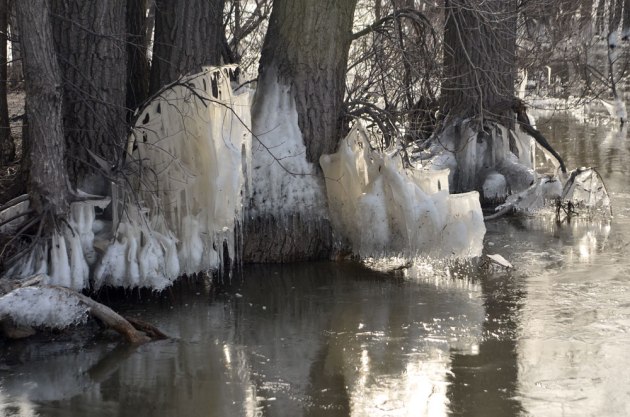
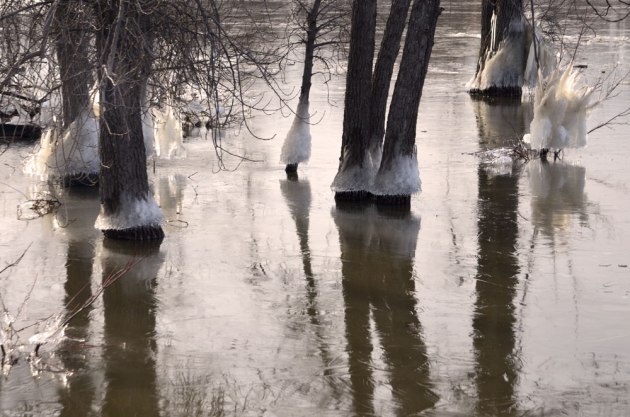
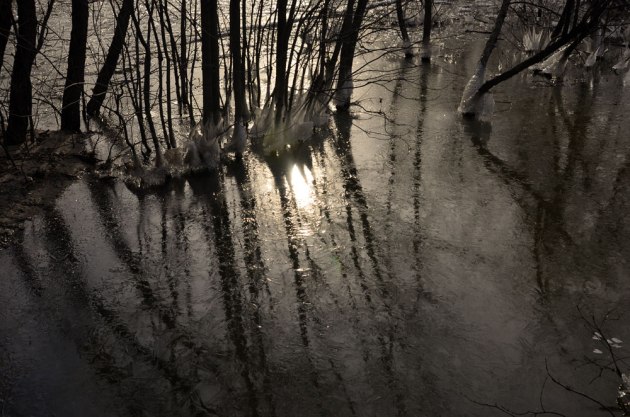
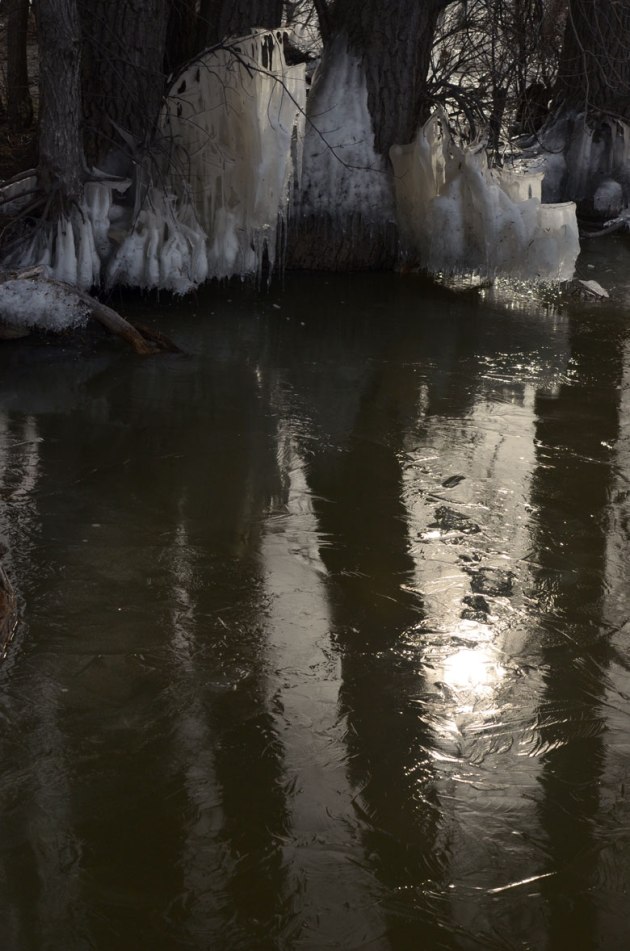

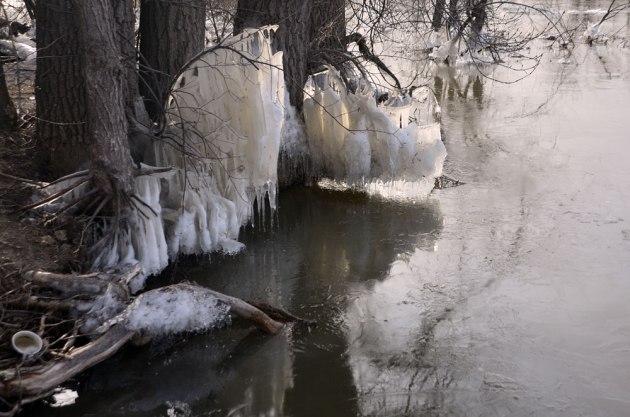
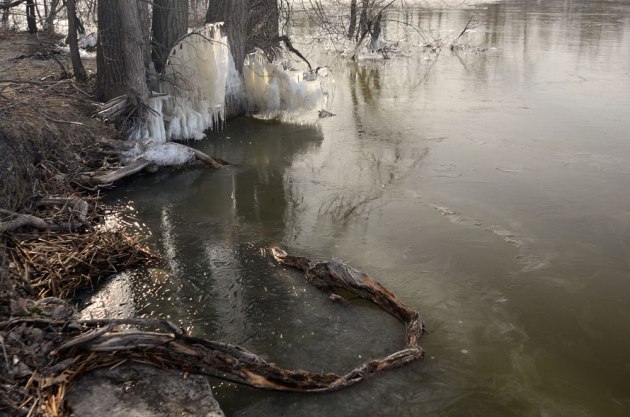 Above images: The Aftermath, April 06, 2016
Above images: The Aftermath, April 06, 2016
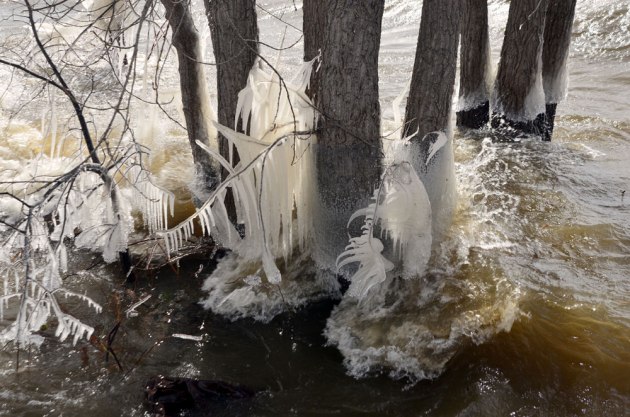 Above image : Wind & Waves, April 03,16.
Above image : Wind & Waves, April 03,16.
Below: click on image to open gallery view.
© Karen McRae, 2016
To me, there’s always been something vaguely sinister about Wellington’s Opera House Lane. That feeling was pretty strong when I was walking through last Wednesday. But it wasn’t the tagging and graffiti grabbing my attention.
The sculptural bulk of the structure overhead – it must be a walkway, I think – the weathered brickwork, and the qualities of the light combined to make it more than usually impressive. And my camera thought so, too.
So here are my three shots. (Oh! you might notice there’s a bit of a photo-shoot happening in #607, by the way.)
This brief post intends to signal that posting to |A Twisted Pair| has recommenced.
It seems not much has changed since then. My last post, on Christmas Eve 2015, carried “an uncommonly handsome view of the Central Police Station – a strong contender, I reckon, for the title of Wellington’s ugliest building.”
Less than a fortnight ago, I posted an image on my Facebook page under the title, REFLECTING ON POLICE BRUTALITY, as follows:
To my eye, the Wellington Central Police Station is one of the ugliest buildings in the city. Upon reflection (in the surfaces of the building on the opposite side of Victoria Street), it does seem more interesting. This image dates from 19 March 2016.
“Brutalist architecture is a movement in architecture that flourished from the 1950s to the mid-1970s, descending from the modernist architectural movement of the early 20th century. The term originates from the French word for “raw” in the term used by Le Corbusier to describe his choice of material béton brut (raw concrete). British architectural critic Reyner Banham adapted the term into “brutalism” (originally “New Brutalism”) to identify the emerging style.”